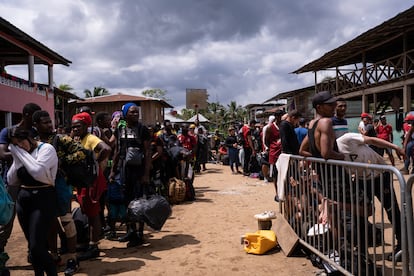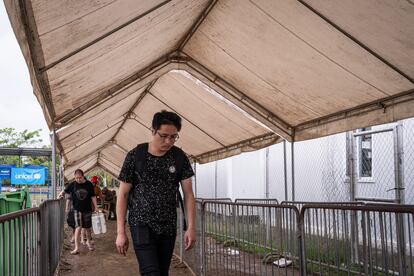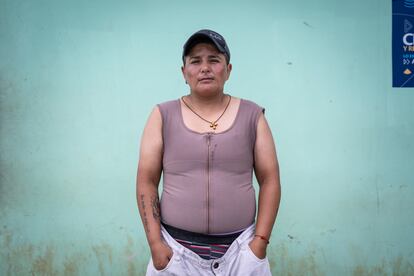The other voices of the Darién Gap
Chinese are now the fourth-largest nationality crossing the dangerous jungle route through Panama. The number of Afghans, Indians and Bangladeshis is also increasing


Hameed Bakhtani was an English teacher in his native Afghanistan. He mainly taught girls, before the Taliban returned to power and banned women from schools and colleges. “I was threatened many times by that group because they wouldn’t give me permission to work if I taught girls. And I have daughters,” Bakhtani says at the San Vicente Migratory Reception Station in Panama. That is why he decided to leave.
Bakhtani and his family are traveling in a group of four families: 16 adults and six children who are exhausted after 20 days of travel and a stretch through the jungle which, Bakhtani says, is the most dangerous thing they have ever done in their lives. From Afghanistan they made their way to Brazil, obtaining a humanitarian visa, and now their goal is to reach the United States.
When the Americans withdrew from Afghanistan, nothing was the same. Not soccer, which he loves, nor the videos on his YouTube channel, nor anyone’s daily life. So far this year, 1,504 Afghans have crossed the dense jungle of the Darién Gap. “We decided to leave the country for a better future for my children, my brothers and sisters,” Bakhtani says as a Red Cross nurse checks his mother.
“We spent two days in the jungle. The worst things were the rain and the hills, so high and dangerous. I wouldn’t recommend any of my people to summon the courage to do that trek. It’s not like anybody told us.”
The latest figures published by the Panamanian authorities reveal that, as well as Venezuelans and Haitians — the two nationalities that top the list of people taking the Darién route — many other languages are beginning to echo in the jungle. More and more Colombians have crossed it: 5,509 so far in 2023.
The situation is so serious that the president of Colombia, Gustavo Petro, recently described the migratory crisis as “a human rights holocaust” and said he would like to visit the Darién Gap to verify it. The humanitarian crisis in the area is critical. According to Verónica Martínez, the head of humanitarian response for the International Federation of Red Cross and Red Crescent Societies (IFRC) in Darién, it is also the most underfunded migration crisis in the world.

A surge in Chinese crossing the Darién
A group of Chinese men and a woman climb out of a pickup truck at the San Vicente Station. They carry suitcases and are impeccable. They do not want to talk to anyone. They register with the Panamanian military, who have trouble understanding the language. They are placed in separate spaces from those occupied by Latin American migrants.
The presence of Chinese migrants is increasingly frequent in the Darién Gap. According to the Panamanian immigration authorities, 7,035 have traversed the jungle so far this year, a record. The main reasons for the influx include the effects of strict anti-vigilance measures and an increasingly authoritarian government.
In general, the migratory flow from Asia is soaring with people from countries including Bangladesh and India. In the latter case, there has been a 370% increase in 2023 compared to the previous year.

Ecuadorians the third most-numerous nationality
Belén, 28, a native of Ecuador, crossed with her eight-year-old son. “I risked death four times crossing the rivers in this jungle. Lack of work and insecurity force people to migrate, but I wouldn’t wish the jungle on anyone,” she says.
She was charged $550 for the crossing. Now she does not know how she will continue her journey. Belén did not tell her family that she would be taking the Darién route. Ecuadorians began to migrate in larger numbers in June 2022 and since then 44,000 people have crossed, placing Ecuadorians third in terms of volume after Venezuelans and Haitians. This year alone, in less than a quarter, 20,069 Ecuadorians have made the journey.

Trans migrants: crossing the jungle to save their lives
The reasons for migrating are sometimes more complex than simply seeking a better life. In many cases people have little choice due to gender discrimination, armed conflict, and political violence.
Suko is a 36-year-old transgender man who risked his life in the jungle to escape a death sentence in his native Ecuador, and to help his brothers. Despite the humidity of the Darién, he wears a girdle and recounts how he traversed the dangerous route in the company of Danys González, a young Venezuelan who provided great support, and a lesbian migrant couple. “They almost killed me in Ecuador, where there is a lot of discrimination against us LGBTQI+ people,” Suko says. On his journey through the Darién Gap, a Haitian saved him from drowning in a river.
Sign up for our weekly newsletter to get more English-language news coverage from EL PAÍS USA Edition
Tu suscripción se está usando en otro dispositivo
¿Quieres añadir otro usuario a tu suscripción?
Si continúas leyendo en este dispositivo, no se podrá leer en el otro.
FlechaTu suscripción se está usando en otro dispositivo y solo puedes acceder a EL PAÍS desde un dispositivo a la vez.
Si quieres compartir tu cuenta, cambia tu suscripción a la modalidad Premium, así podrás añadir otro usuario. Cada uno accederá con su propia cuenta de email, lo que os permitirá personalizar vuestra experiencia en EL PAÍS.
¿Tienes una suscripción de empresa? Accede aquí para contratar más cuentas.
En el caso de no saber quién está usando tu cuenta, te recomendamos cambiar tu contraseña aquí.
Si decides continuar compartiendo tu cuenta, este mensaje se mostrará en tu dispositivo y en el de la otra persona que está usando tu cuenta de forma indefinida, afectando a tu experiencia de lectura. Puedes consultar aquí los términos y condiciones de la suscripción digital.
More information
Archived In
Últimas noticias
Maduro pleads not guilty before the federal court in New York: ‘I am still the president of Venezuela’
A new test can detect Alzheimer’s from a finger prick
UN team enters Sudanese city of El Fasher after paramilitary massacre: ‘It’s like a ghost town’
A recipe for resistance: Indigenous peoples politicize their struggles from the kitchen
Most viewed
- Gilles Lipovetsky: ‘If you want to live better and fall in love, take Prozac, don’t look to philosophy’
- Alain Aspect, Nobel laureate in physics: ‘Einstein was so smart that he would have had to recognize quantum entanglement’
- Alvin Hellerstein, a 92-year-old judge appointed by Bill Clinton, to preside over Maduro’s trial in New York
- Maduro’s downfall puts China’s relationship with Venezuela to the test
- Why oil has been at the center of Venezuela-US conflicts for decades










































